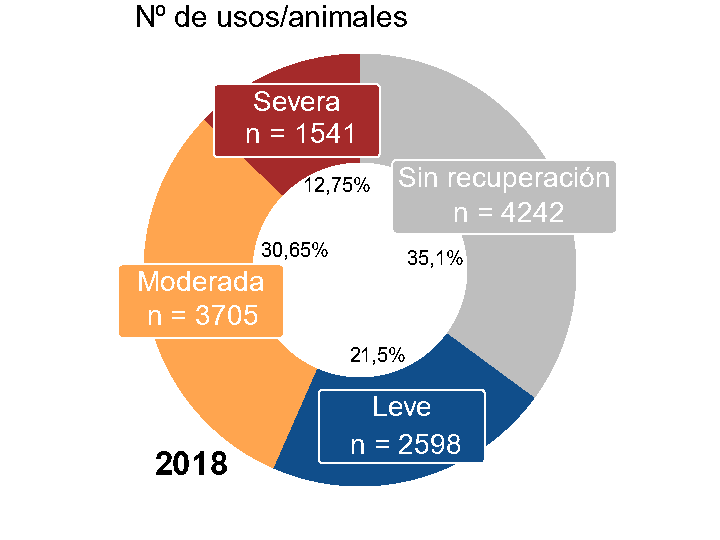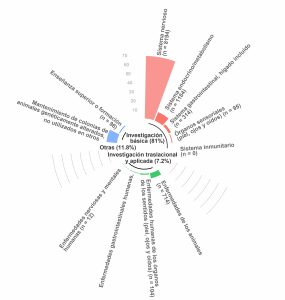Curso académico 2018/19
Actividades realizadas
- Informe de transparencia: Uso de animales con fines científicos en la UMH en los años 2017 y 2018
- Divulgación de avances biomédicos gracias al uso de animales en investigación:
- La UMH y la Universidad Eslovaca de Agricultura colaborarán en nuevas líneas de investigación
- Seminario “Descifrando la secuencia de reconocimiento táctil”
- Seminario sobre inmunología en peces para la prevención de enfermedades en acuicultura
- Investigadores del Instituto de Neurociencias descubren la conexión que permite la coordinación bilateral de la visión en mamíferos
- El IN participa en un estudio que demuestra que la actividad física prepara a las neuronas para regenerarse en caso de lesión medular
- Un estudio del Instituto de Neurociencias UMH-CSIC prueba que el sentido del tacto surge en el cerebro antes del nacimiento
- Seminario sobre la disección genética de la formación de los órganos en los animales
- La UMH renueva su presencia en la Comisión Autonómica de Bienestar de los Animales de Experimentación
- La Generalitat concede a 4 investigadores de la UMH la subvención para contratación de personal investigador en fase postdoctoral
- La UMH organiza un seminario sobre estrategias en opiáceos como tratamientos del dolor crónico y otro sobre sistemas pseudo-ordenados
- La Cámara de Comercio premia a la spin-off Centro CREA del Parque Científico por su labor en el tratamiento de trastornos alimentarios
- Un estudio del Instituto de Neurociencias revela que el daño cerebral inducido por el alcohol no cesa inmediatamente al dejar de beber
- La Academia Americana de Oftalmología entrega el “Premio de Honor a la Trayectoria” al profesor Jorge Alió
- Buscador de estudios con animales en la UMH: http://research.umh.es/vivo/
- Instrucciones de uso:
- En el cajón buscador introducir la especie animal y el año. Ejemplo: Mice 2018
- En el menú que aparece a la derecha seleccionar: Research
- Aparecerán los artículos y posters relacionados
- También se puede acotar la búsqueda por enfermedades. Ejemplo: Anxiety mice 2018
- Instrucciones de uso:
- Promoción de las 3 Rs y divulgación de la utilidad de la investigación con animales:
- Informe de los Estados Miembros de la Unión Europea sobre las estadísticas del uso científico de animales de 2018
- Informe anual 2018 del Acuerdo de transparencia sobre el uso de animales en experimentación científica en España
- ¿Por qué usar ratones en investigación?
- Investigar con animales en España es dificilísimo, y así debe ser
- Directrices para el tratamiento de animales en la investigación y la enseñanza del comportamiento
- Premio sobre refinamiento de EPAA (European Partnership for Alternative Approaches to Animal Testing)
- Estudio del autismo in vitro como alternativa a la experimentación animal
- Informe de EURL ECVAM sobre el estado del desarrollo, validación y aceptación regulatoria de los métodos alternativos y sus aproximaciones (2018)
- Criterios de punto final para modelos animales de ELA
- Infografía sobre el papel fundamental de los animales para desarrollar nuevas vacunas y salvar millones de vidas cada año
- Aprendizaje automático para refinar los criterios de punto final
- La UMH renueva su presencia en la Comisión Autonómica de Bienestar de los Animales de Experimentación
- Percepciones frente a realidad en la investigación con animales. Un folleto divulgativo que pretende aclarar algunos mitos erróneos sobre el uso de animales en investigación biomédica
- La formación continua es la mejor manera de avanzar en la aplicación de las 3 erres: Reemplazo, Reducción y Refinamiento
- ¿Amas a los animales? Apoya la la investigación con animales. Nueva inciativa de Foundation for Biomedical Research
- Fish Behaviour Index (FBI): Un interesante software para valorar el bienestar del pez cebra de manera fiable, lo que permite refinar los procedimientos.
- La investigación con modelos animales, vital para las enfermedades raras
- La guía ARRIVE está siendo revisada para mejorar su impacto en la calidad de las publicaciones científicas que implican el uso de animales
- Sí, el sexo pueden condicionar los resultados en la investigación con animales. ¿Lo tienes en cuenta?
- Actividades de divulgación:
- Jornada de puertas abiertas en la Semana Mundial del Cerebro celebrada los días 11-17 de Marzo de 2019 en el Instituto de Neurociencias, centro mixto UMH-CSIC, donde se abordó el tema con diferentes charlas divulgativas, exposiciones…
- I Jornada de puertas abiertas de la Facultad de Medicina de la UMH celebrada el día 3 de Octubre de 2018, en la que se impartió el Taller «Aprendiendo de los animales» a alumnos de primaria y secundaria, donde se explicó la importancia y la necesidad que sigue habiendo hoy en día del uso de animales en la investigación.
- Vídeo divulgativo sobre el Servicio de Experimentación Animal de la UMH:
- Visitas guiadas a los animalarios para alumnos de:
- Centros de educación secundaria
- Estudiantes de grado
- Formación:
- Formación inicial funciones a, b, c y d curso académico 2018/19
- Formación continua:
- Seminarios de introducción a la experimentación animal y a la solicitud de proyectos de investigación con animales para estudiantes de grado (psicología, farmacia…)
Uso de animales en experimentación en la UMH en el año 2018
El número de animales utilizados por primera vez (en su primer uso) con fines de investigación y ensayo, para docencia, así como para la creación y el mantenimiento de líneas animales genéticamente alteradas en la UMH ha sido superior a los 10.000 animales en el año 2018. Sin embargo, se observa una ligera tendencia a la baja en comparación con el año 2017 (n = 13176 usos).
El año 2018, los animales usados en la Universidad Miguel Hernández representaron un 1,44% del total usado en España en 2018 (n = 836.096). Los mamíferos han constituido un 94,3% (n = 11402) de los animales usados en experimentación, siendo las especies utilizadas: el ratón, la rata, el hurón, la cobaya, el conejo y el cerdo. Los peces han constituido el 5,7% (n = 684) de los animales restantes.

El siguiente gráfico representa la proporción de animales que ha sido sometida a un procedimiento con un determinado grado de severidad. Se observa que el grado de severidad de los procedimientos que predomina es «Sin recuperación» con 4242 animales (35,1%), seguido de la severidad «Moderada» (n = 3075, 30,65%), severidad «Leve» (n = 2598, 21,5%) y, por último, «Severa» con 1541 animales (12,75%). En el informe de 2018 del Ministerio de Agricultura, Pesca y Alimentación, el porcentaje de procedimientos «Sin recuperación» y «Leve (como máximo)» se desvían considerablemente de los de la UMH («Sin recuperación» 4,75%, y «Leve (como máximo)» 52,12%); mientras que el porcentaje de procedimientos con severidad «Moderada» y «Severa» es similar: 35,90% y 7,22%, respectivamente.

En cuanto a la información recogida respecto a la finalidad científica del uso de los animales, destaca el uso de la investigación básica (81%) predominando la investigación en el «Sistema nervioso». La investigación traslacional y aplicada este año solamente ha representado el 7,2% de los usos, siendo la «Enfermedad de los animales» el principal campo de investigación.

Se puede encontrar más información en el informe de transparencia que se encuentra al principio de esta página.
Información relativa al uso de animales de experimentación en España:
Información relativa al uso de animales de experimentación en Europa:
- Informe de la Comisión al Parlamento Europeo y al Consejo. Informe de 2019 sobre las estadísticas relativas al uso de animales con fines científicos en los Estados miembros de la Unión Europea en 2015-2017.
- Análisis de las estadísticas de la Unión Europea en el artículo publicado en la revista ALTEX:
Artículos publicados
- The centrosome protein AKNA regulates neurogenesis via microtubule organization
- Cbp-dependent histone acetylation mediates axon regeneration induced by environmental enrichment in rodent spinal cord injury models
- Rag1 immunodeficiency-induced early aging and senescence in zebrafish are dependent on chronic inflammation and oxidative stress
- Regulatory T Cells Restrict Permeability to Bacterial Antigen Translocation and Preserve Short-Chain Fatty Acids in Experimental Cirrhosis
- Prenatal activity from thalamic neurons governs the emergence of functional cortical maps in mice
- Timing of Exposure and Bisphenol-A: Implications for Diabetes Development
- Ligand-based design identifies a potent NUPR1 inhibitor exerting anticancer activity via necroptosis
- FXR modulates the gut-vascular barrier by regulating the entry sites for bacterial translocation in experimental cirrhosis
- Effects of corneal injury on ciliary nerve fibre activity and corneal nociception in mice: A behavioural and electrophysiological study
- CBP and SRF co-regulate dendritic growth and synaptic maturation
- Effect of stress on somatic cell count and milk yield and composition in goats
- The Immunosuppressant Macrolide Tacrolimus Activates Cold-Sensing TRPM8 Channels
- Cannabidiol regulates the expression of hypothalamus-pituitary-adrenal axis-related genes in response to acute restraint stress
- Distinct molecular programs regulate synapse specificity in cortical inhibitory circuits
- A Retino-retinal Projection Guided by Unc5c Emerged in Species with Retinal Waves
- O-hexyl O-2,5-dichlorophenyl phosphoramidate as a substrate for domestic and sea bird serum A-esterases: Hydrolysis levels, Cu(2+)- and Zn(2+)-dependence and stereoselectivity
- Pancreatic alpha-cell mass in the early-onset and advanced stage of a mouse model of experimental autoimmune diabetes
- Impact of Different Titanium Implant Thread Designs on Bone Healing: A Biomechanical and Histometric Study with an Animal Model
- Cannabidiol does not display drug abuse potential in mice behavior
- Distribution of GABAergic Neurons and VGluT1 and VGAT Immunoreactive Boutons in the Ferret (Mustela putorius) Piriform Cortex and Endopiriform Nucleus. Comparison With Visual Areas 17, 18 and 19
- Extensive branching of radially-migrating neurons in the mammalian cerebral cortex
- Rainbow Trout Red Blood Cells Exposed to Viral Hemorrhagic Septicemia Virus Up-Regulate Antigen-Processing Mechanisms and MHC I&II, CD86, and CD83 Antigen-presenting Cell Markers
- Inactivation of NUPR1 promotes cell death by coupling ER-stress responses with necrosis
- The Amniote Oculomotor Complex
- CBP/p300 in brain development and plasticity: disentangling the KAT’s cradle
- Biomechanical and Histological Analysis of Titanium (Machined and Treated Surface) Versus Zirconia Implant Materials: An In Vivo Animal Study
- Decreased circulating ErbB4 ectodomain fragments as a read-out of impaired signaling function in amyotrophic lateral sclerosis
- Plasma proteomic analysis of zebrafish following spring viremia of carp virus infection
- Microstructural White Matter Alterations in Men With Alcohol Use Disorder and Rats With Excessive Alcohol Consumption During Early Abstinence
- The calmodulin-binding tetraleucine motif of KCNE4 is responsible for association with Kv1.3
- IFIT5 Participates in the Antiviral Mechanisms of Rainbow Trout Red Blood Cells
- Expression of the cold thermoreceptor TRPM8 in rodent brain thermoregulatory circuits
- The peripheral eye: A neurogenic area with potential to treat retinal pathologies?
- Determination of intestinal permeability using in situ perfusion model in rats: Challenges and advantages to BCS classification applied to digoxin
- In utero exposure to bisphenol-A disrupts key elements of retinoid system in male mice offspring
- The Epigenetic Factor CBP Is Required for the Differentiation and Function of Medial Ganglionic Eminence-Derived Interneurons
- Location and Plasticity of the Sodium Spike Initiation Zone in Nociceptive Terminals In Vivo
- Loss of Cntnap2 Causes Axonal Excitability Deficits, Developmental Delay in Cortical Myelination, and Abnormal Stereotyped Motor Behavior
- A 3D Convolutional Neural Network to Model Retinal Ganglion Cell’s Responses to Light Patterns in Mice
- 1-(2′,5′-Dihydroxyphenyl)-3-(2-fluoro-4-hydroxyphenyl)-1-propanone (RGM079): A Positive Allosteric Modulator of a7 Nicotinic Receptors with Analgesic and Neuroprotective Activity
- Improved hemodynamic and liver function in portal hypertensive cirrhotic rats after administration of B. pseudocatenulatum CECT 7765
- TherMouseDuino: An affordable Open-Source temperature control system for functional magnetic resonance imaging experimentation with mice
- Non-invasive MRI windows to neuroinflammation
- Fish Red Blood Cells Modulate Immune Genes in Response to Bacterial Inclusion Bodies Made of TNFa and a G-VHSV Fragment
- The occurrence and dynamics of polychlorinated hydrocarbons in roe deer (Capreolus capreolus) in South-western Slovakia
- Emerging evidence for the modulation of exocytosis by signalling lipids
- Turbot (Scophthalmus maximus) Nk-lysin induces protection against the pathogenic parasite Philasterides dicentrarchi via membrane disruption
- Correlated response in body condition and energy mobilisation in rabbits selected for litter size variability
- Transcranial direct-current stimulation (tDCS) improves detection of simple bright stimuli by amblyopic Long Evans rats in the SLAG task and produces an increase of parvoalbumin labelled cells in visual cortices
- Hydroxycholesterol binds and enhances the anti-viral activities of zebrafish monomeric c-reactive protein isoforms
- Potential Role of Rainbow Trout Erythrocytes as Mediators in the Immune Response Induced by a DNA Vaccine in Fish
- Microgrooves and Microrugosities in Titanium Implant Surfaces: An In Vitro and In Vivo Evaluation
- Litter Survival Differences between Divergently Selected Lines for Environmental Sensitivity in Rabbits
- Rainbow Trout Erythrocytes ex vivo Transfection With a DNA Vaccine Encoding VHSV Glycoprotein G Induces an Antiviral Immune Response
- Double Drug Delivery Using Capped Mesoporous Silica Microparticles for the Effective Treatment of Inflammatory Bowel Disease
- Integrated Transcriptomic and Proteomic Analysis of Red Blood Cells from Rainbow Trout Challenged with VHSV Point Towards Novel Immunomodulant Targets
- Chromatin immunoprecipitation and high throughput sequencing of SVCV-infected zebrafish reveals novel epigenetic histone methylation patterns involved in antiviral immune response
- Using Drosophila Models and Tools to Understand the Mechanisms of Novel Human Cancer Driver Gene Function
- Correlated response to selection for litter size environmental variability in rabbits’ resilience
- The caudo-ventral pallium is a novel pallial domain expressing Gdf10 and generating Ebf3-positive neurons of the medial amygdala
- Pharmacological regulation of cannabinoid CB2 receptor modulates the reinforcing and motivational actions of ethanol
- Influence of hydroxyapatite granule size, porosity, and crystallinity on tissue reaction in vivo. Part B: a comparative study with biphasic synthetic biomaterials
- Gender differences in the effects of cannabidiol on ethanol binge drinking in mice
- Demineralized Bone Matrix Coating Si-Ca-P Ceramic Does Not Improve the Osseointegration of the Scaffold
- Copper-dependent hydrolysis of trichloronate by turkey serum studied with use of new analytical procedure based on application of chiral chromatography and UV/Vis spectrophotometry
- The Megalocytivirus RBIV Induces Apoptosis and MHC Class I Presentation in Rock Bream (Oplegnathus fasciatus) Red Blood Cells
- Synaptic mechanisms underlying the intense firing of neocortical layer 5B pyramidal neurons in response to cortico-cortical inputs
- Gene delivery to the rat retina by non-viral vectors based on chloroquine-containing cationic niosomes
- Bisphenol A Regulates Sodium Ramp Currents in Mouse Dorsal Root Ganglion Neurons and Increases Nociception
- Cortistatin regulates glucose-induced electrical activity and insulin secretion in mouse pancreatic beta-cells
- Deletion of Dlk1 increases the vulnerability to developing anxiety-like behaviors and ethanol consumption in mice
- A Chronic Ocular-Hypertensive Rat Model induced by Injection of the Sclerosant Agent Polidocanol in the Aqueous Humor Outflow Pathway
- Selective neuronal death following exposure to methylenedioxypyrovalerone is accompanied by an inhibition of NMDA receptor NR2B subunit expression
- Influence of Olive Extracts on the Expression of Genes Involved in Lipid Metabolism in Medaka Fish
- Gene transfer to rat cerebral cortex mediated by polysorbate 80 and poloxamer 188 nonionic surfactant vesicles
- Single versus double experimental bile duct ligation model for inducing bacterial translocation
- Non-viral vectors based on cationic niosomes as efficient gene delivery vehicles to central nervous system cells into the brain
- Polysorbate 20 non-ionic surfactant enhances retinal gene delivery efficiency of cationic niosomes after intravitreal and subretinal administration
- Complex hybridization patterns in European pond turtles (Emys orbicularis) in the Pyrenean Region
- Non-viral vectors based on cationic niosomes and minicircle DNA technology enhance gene delivery efficiency for biomedical applications in retinal disorders
- Different behavior of polyphenols in energy metabolism of lipopolysaccharide-stimulated cells
- Impact on intestinal permeability of pediatric hyperosmolar formulations after dilution: Studies with rat perfusion method
- Long-Circulating Hyaluronan-Based Nanohydrogels as Carriers of Hydrophobic Drugs
- Multiscale dynamics of interstimulus interval integration in visual cortex
- Comparative study of extracellular recording methods for analysis of afferent sensory information: Empirical modeling, data analysis and interpretation
- Ion-pair approach coupled with nanoparticle formation to increase bioavailability of a low permeability charged drug